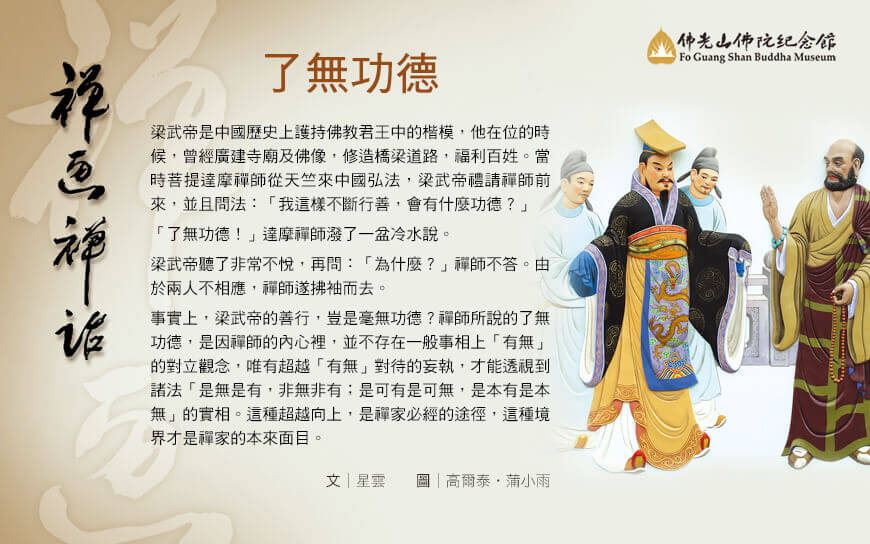語音導覽 - 禪畫禪話Audio Guide - Chan Art and Stories

梁武帝是中國歷史上護持佛教君王中的楷模,他在位的時候,曾經廣建寺廟及佛像,修造橋梁道路,福利百姓。當時菩提達摩禪師從天竺來中國弘法,梁武帝禮請禪師前 來,並且問法:「我這樣不斷行善,會有什麼功德?」
「了無功德!」達摩禪師潑了一盆冷水說。
梁武帝聽了非常不悅,再問:「為什麼?」禪師不答。由於兩人不相應,禪師遂拂袖而去。
事實上,梁武帝的善行,豈是毫無功德?禪師所說的了無功德,是因禪師的內心裡,並不存在一般事相上「有無」的對立觀念,唯有超越「有無」對待的妄執,才能透視到諸法「是無是有,非無非有;是可有是可無,是本有是本無」的實相。這種超越向上,是禪家必經的途徑,這種境界才是禪家的本來面目。

During the Liang Dynasty, Emperor Wu was a model ruler famous for building and repairing roads and bridges, and especially for building many temples to propagate Buddhism. When the Emperor heard that Bodhidharma had arrived from India to spread the Dharma, he invited him to visit.
“I have built many temples,” the Emperor told Bodhidharma. “What merit have I gained?”
“No merit whatever.” Bodhidharma replied. Without offering any explanation, Bodhidharma took leave of the deflated Emperor with a flip of his sleeve.
When we reject the false duality of being and non-being, we can see that our “good deeds” gain “no merit whatever”. When we transcend our deluded attachment to duality, we can appreciate the reality of all dharmas: “there is non-existence, there is existence, there is not non-existence, there is not existence, there may be existence, there may be non-existence, there is originally existence, there is originally non-existence.” This transcendence is the path that every Chan practitioner must take. It is the original face of Chan practice.
 上一則
上一則